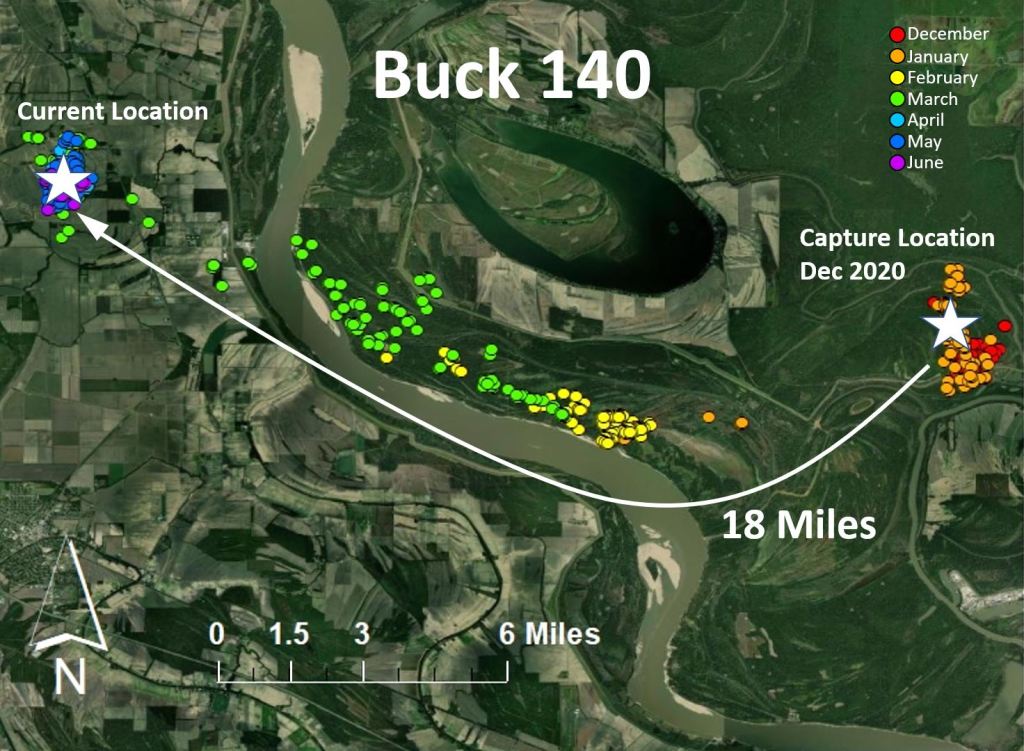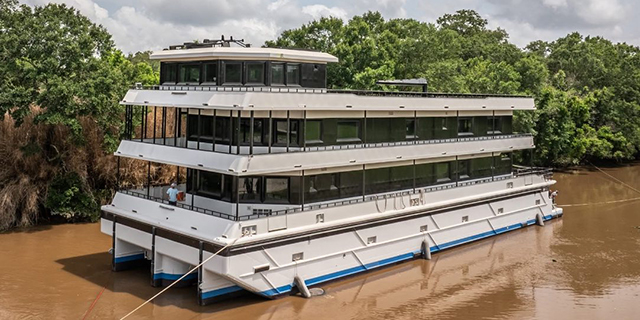Buck 140’s excellent adventures include crossing river four times
Published 4:00 am Sunday, December 18, 2022

- Graphic shows the movement of Buck 140, which was captured, tranquilized and fitted with a GPS radio collar and ear tags in December 2020. This chart of the deer's movements was published in June 2021. It has crossed the Mississippi River four times since 2020.
The life and times of Buck 140, a big, healthy deer outfitted with a GPS radio collar two years ago in Mississippi, are a testament to the movement of adult male white-tailed deer.
Since being captured, tranquilized and fitted with the electronics hardware, plus ear tags, two years ago this month in southwestern Mississippi, Buck 140 has traveled 18 miles one way twice each year from his summer home in Louisiana to his winter range in the South Delta of Mississippi. Its forays include swimming four times at the same location across the Mississippi River, where it’s one mile wide, to get back and forth.
The Mississippi State University Deer Lab and Mississippi Department of Wildlife, Fisheries and Parks first implemented the study to monitor major movement of different bucks by fitting 92 deer with tracking collars. The biologists received significant movement data from 45 deer that moved along the Big Black River in Madison and Yazoo counties, then expanded the research to the South Delta.
“We documented major movement in the deer, which led to intriguing patterns in the deer we collared. When we analyzed the annual home range, we noticed two patterns of movement, one being a sedentary personality and one being a mobile personality,” Steve Demarais, MSU Deer Lab co-director and well-known expert in deer ecology, said when the project began.
Buck 140 was collared by Luke Resop, a master’s student in MSU’s Department of Wildlife, Fisheries and Aquaculture, in Issaquena County. Each collar was programmed to fall off last month.
However, Buck 140’s collar disengaged prematurely in August. By chance, it was found Nov. 26 by Michael Langdon of Madison, Mississippi.
Madison, who had followed numerous stories about Buck 140 in The Clarion Ledger, knew exactly what he had that day he was hunting deer in the rain on the Phil Bryant Wildlife Management Area’s 10 Point Unit.
“It was Saturday and it was raining and I found an old wooden shooting house and I got under it to get out of the rain. The rain let up and I decided to get up and move a little bit,” Langdon said in Brian Broom’s story published Dec. 7 in The Clarion Ledger.
A few minutes later he saw something orange on the ground about 20 yards away. At first he thought it was trash before he picked it up and realized it was a radio collar, which he put in his pack.
Langdon looked at it closely when he got home and saw the number 140.
“I was aware of the deer because I’d followed the story through the years. I realized the significance of it when I pulled it out. I knew I’d really found something then. I was excited,” he said.
Langdon called Broom, who contacted Resop at the MSU Deer Lab. Resop said the collar was found 200-300 yards from where he captured and collared the buck.
“He (Resop) referred to that deer as the most famous GPS-collared deer in North America. I would have to agree because everyone I’ve talked to knows the story well,” Langdon said.
“It’s absolutely fascinating. That collar and that deer has been across the Mississippi River four times that we know of. His ability to make that far of a journey blows my mind. It almost seems impossible.”
Buck 140 spent spring and early summer in Louisiana and returned in August to the South Delta. The deer traveled far and crossed on of the largest rivers in the world and also stopped at or near the same places along his journey.
Why?
Demarais doesn’t believe it was because flooding conditions.
“There was flooding taking place when he made the movement, but he didn’t have to go to Louisiana. He swam the Mississippi River, so he didn’t get let wet by doing this,” he said Aug. 26 in The Clarion Ledger.
Food sources weren’t the reason, either. Agricultural crops, including soybeans, and other food sources were available in Louisiana when he left.
Resop addressed the question in a news release from MSU.
“The point of conducting scientific research, like this, is to better understand the behavior of white-tailed deer. Compared to past research and the differences our team found, we can see that deer have personalities and are unique in how they act, live and survive,” he said, noting there are “homebodies” and there are “travelers.”
The project’s goal is to get a better understanding of deer ecology to inform management decisions. It’s also a tool to determine if deer are spreading Chronic Waste Disease over long distances.





